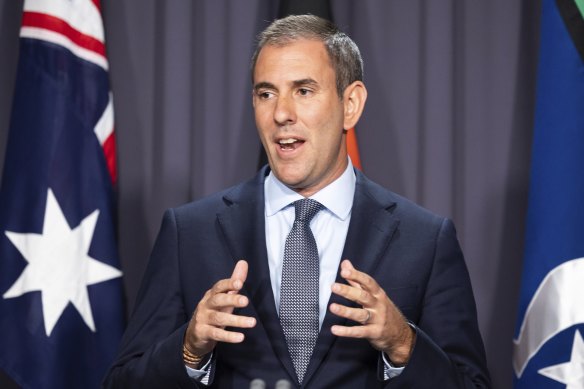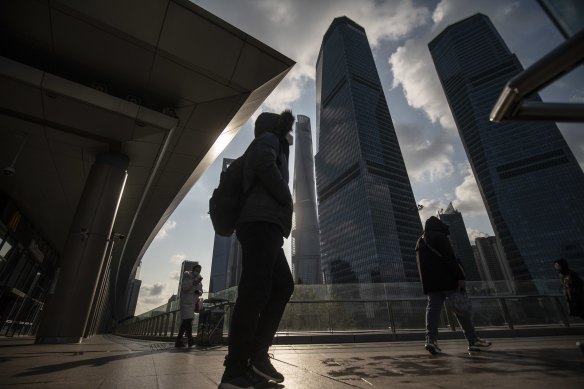This was published 2 years ago
China’s COVID-plagued slowdown threatens Australia’s economic recovery
By Eryk Bagshaw and Rachel Clun
China’s sluggish economy is threatening to derail Australia’s economic recovery, as its annual growth rate more than halves after months of pandemic volatility.
China’s annual gross domestic product growth slumped to one of the worst results in 50 years, falling from 8 per cent in 2021 to 3 per cent last year, figures released on Tuesday revealed.

Treasurer Jim Chalmers. Credit: Alex Ellinghausen.
The Australian government is on high alert for further deterioration from soaring COVID-19 infection numbers after months of lockdowns and unrest.
Responding late on Tuesday to the data from Beijing’s National Bureau of Statistics, Treasurer Jim Chalmers said China’s slowing growth was “one of the major economic challenges facing Australia at the start of 2023”.
“The global economy is a volatile place right now and developments in China are a big part of that,” he said.
Australia remains highly exposed to Chinese importers, particularly in the resources sector, even as the local economy shows signs of strong COVID-bounce-back.
The surge in Chinese demand helped Australia emerge from the 2008 global financial crisis in better shape than almost any other advanced economy, but Chalmers warned on Tuesday that it could not rely on a similar push to drive Australia out of the COVID-economic crisis.
China is Australia’s largest trading partner, and the sixth-largest foreign direct investor (worth $44 billion in 2020). Before COVID, China was Australia’s biggest source of international students and tourism.
Trade with China accounts for nearly a third of all Australian global trade, according to the Department of Foreign Affairs and Trade. It was worth $245 billion in 2020. Despite the strong headline figures, the trade relationship has been rocky, with unofficial trade bans placed on Australian goods coal, wine, beef, and barley as diplomatic relations deteriorated throughout the pandemic.
But there are signs some of those trade embargoes are now being lifted following Foreign Minister Penny Wong’s trip to Beijing for the 50th anniversary of Chinese-Australian diplomatic relations. Last week, three state-linked utilities and a major steelmaker were allowed to resume some coal imports from Australia.
The official figures from the Chinese government agency have been met with scepticism by economists, who believe the real figures - China’s second-weakest growth rate since the end of the Cultural Revolution in 1976 - are much worse than have been publicly revealed.
“China’s statistics bureau claims that GDP was unchanged [in the fourth quarter of 2022],” said Capital Economics senior China economist Julian Evans Pritchard.
“That is implausible, even accounting for December data showing surprising economic resilience in the face of the reopening wave of infections.”
China’s short-term threat is being exacerbated by a long-term demographic cliff that has serious implications for the Chinese economy.

China’s annual gross domestic product growth slumped to one of the worst results in 50 years.Credit: Bloomberg
The National Bureau of Statistics revealed on Tuesday that China’s population had shrunk for the first time since 1961. The mark is expected to be the first of many decreases in the Chinese population of 1.4 billion, which is expected to fall to 800 million by 2100.
Louise Loo, a senior economist at Oxford Economics said there was some good news in the data.
“There are now signs of stabilisation, as policy support doled out towards the end of 2022 is showing up in the relative resilience of infrastructure investment and credit growth,” she said.
The Australian economy grew at nearly double the rate of China’s in 2022. A surge in household spending on dining out, apparel and new cars helped drive economic growth to 5.9 per cent through the year to September, despite interest rate hikes adding pressure to mortgage repayments.
Household spending remained strong through the holiday period, jumping 11.4 per cent through the year to November according to the Australian Bureau of Statistics, but that growth is expected to slow as interest rate hikes and high inflation continue to bite.
Treasury forecasts economic growth to slow to 3.25 per cent for the 2022-23 financial year, and fall to just 1.5 per cent in 2023-24.
Cut through the noise of federal politics with news, views and expert analysis from Jacqueline Maley. Subscribers can sign up to our weekly Inside Politics newsletter here.